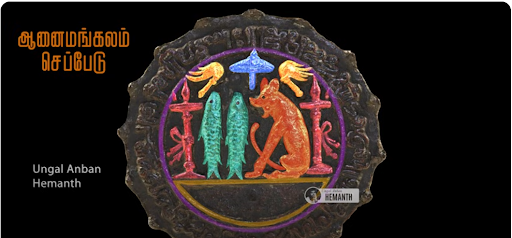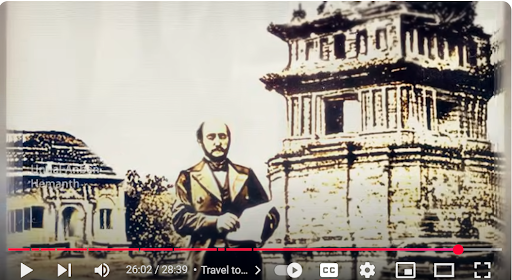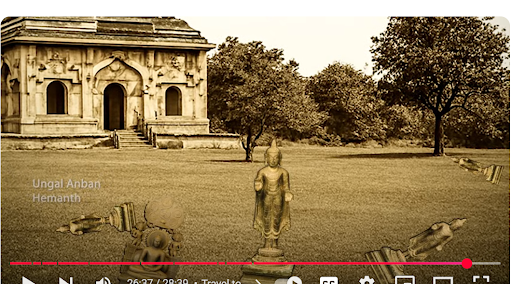Blog 163 - Marine Musings - A Set of Copper Plates that Traversed a Millennium and a Continent - Chapter 2
- ranganathanblog
- Aug 23
- 4 min read
A Set of Copper Plates that Traversed a Millennium and a Continent - Chapter 2
Chola Treasure in the Netherlands! | Anaimangalam Seppedugal (Or the Copper Plates of Anaimangalam) | Raja Raja Cholan

This is the concluding chapter of the whereabouts of the Chola Period Seppedugal (Copper Plates)
The story now moves to the Netherlands.
That nation of placid and tranquil countrysides, filled with tulips and windmills with the picture-postcard settings.
That nation with gleaming skyscrapers and business enterprises with tentacles into every third world country, even post colonisation.
That nation that ranks 5th in the ‘Happiness Index’.
Dig deep enough and you will reach the source and foundation of their prosperity - slavery and the loot from colonisation.
Although miniscule in size to the overall quantity plundered - culturally and financially - the Seppedugal, the copper plates of this story is one such plunder.

Netherlands - the land of Tulips and Windmills

Amsterdam to Leiden

The author recites in his own words. (Translated from Tamil)
“I had waited for a long time to see this treasure of Tamil history. When I finally got the appointment - to the Leiden University Library which housed these ‘Alaimangalam Seppedu’ - I spent quite a sum of money in travelling to the Netherlands and, finally, to Leiden University Library. I waited impatiently in the Library before I was called to a Special Section of the Library. My heart was beating fast as I knew that at last one of my dreams would be coming true.

Mesmerised, I could not take my eyes off this treasure of Indian history.
There were 21 plates to the entire set. The first five in Sanskrit and the other 15 in medieval Tamil.
Each copper plate was 14 inches long and 5 inches wide, nearly 30 kilos in weight.
The ring through which the copper plates were kneaded, were sealed off with the Royal Chola Seal.

(Seppedugal)


There were 21 copper plates. The first five in Sanskrit and the other 16 in Tamil.

Note the large circular copper ring that passes through the hole on each plate and binds / files them together.

The Royal Seal of the Cholas, called ‘Lakhshinai’.
Interpretation of the Seal:

The Tiger - Symbol of the Cholas

Then the two fishes - actually a symbol of the Pandya dynasty

The arc of the hemisphere contains the symbol of the Cheras, the bow and arrow

An umbrella on top, symbolising the coming together of the three dynasties of South India under one roof, under the aegis of the Cholas. (The Cholas, under Raja Raja Cholan, reigned supreme and were at the height of their dynastical powers at that time, having conquered the Pandyas and Cheras).

The two ‘kuthuvillaku’ (lamps with wicks and oil) on either side, symbolising ‘Eternal Light to the World’ as per the Hindu Faith

Two white lotus’ on either side of the umbrella

The letters circling the seal state :

The letters around the Seal

What the letters contain (left) and what it states (right) (translated into Tamil)

Enhanced using a technique known as 3D ‘Photogrammetry’

Image showing one of the copper plates, with Tamil inscriptions

The first page - in Sanskrit
The first five leaves - in the Granth script of Sanskrit - give complete genealogical details of the Chola Dynasty. One interesting detail gleaned from these five pages was that one of the old kings was named ‘Cholan’, from which the Chola dynasty took its name.
The rest, 26 pages, relates the details of the deed, its allocation of the village of Anaimangalam - more or less all the details discussed in Chapter 1.

Hemanth, the author, reading from one of the Tamil pages
So, how did a set of Chola copper scrolls from Thanjavur reach a Library in Leiden, Netherlands?
One of the officials working for the Dutch East India Company, Florentius Camper, took the set of scrolls with him to the Netherlands 300 years ago.
They are now called “the Leiden Copper Plates”, without regard to the historical value of Indian history, in this case the Cholas.

Proof that it belongs to India - the inscription of the name of the village, “Anaimangalam”, at the base of the seal of the Cholas.
A twist to the tale of the allotment of land takes place some 75 years after the Buddhist Monastery was consecrated. Kulothunga Cholan was on the throne. Two delegates from the then ruling SriVijaya king approach the Chola king to tell him that middlemen have taken over the running of the village and are proving to be a hindrance to the Buddhist Monastery.
They pray to the Chola king to redeem the village from the clutches of the middlemen and return it back to the Buddhists.
This was done. Another set of copper plates documented this.
This set also is possessed by the Library in Leiden and are known as “The Leiden Smaller Plates”.
3 pages, with the seal of Kulothunga Cholan.

The author closely examines the ‘Smaller Plates’

The ‘Seppedugal’ being wheeled back to the vault, once again lost to India

Rajendra Cholan, son and successor to Raja Raja Chola, who initiated the document’s inscription into Seppedugal - Copper Plates.
(An interesting fact is that the TS Rajendra, successor to the training ship TS Dufferin, is named after the great Chola king Rajendra Cholan. Why? Therein lies a tale).
So, what is the fate of the Buddhist Monastery?
The Buddhist Monastery, known as Soolamani Viharam’ slowly lost its relevance and, over the centuries and over the many raids and battles fought in its vicinity, fell to ruin.
Nearly 800 years later, in 1846, a Britisher, Sir Walter Elliot, notices a strange spire which was not in consonance with existing Temple Gopurams and sketches it.



Then the French occupy Nagapattinam and missionaries raze the monastery to build a college.

Even today, any and all archaeological digs in the area throw up Buddhist sculptures.
The only evidence we have, today, of an extraordinary series of events that took place a thousand years ago is not in any record in Indian shores, but in the Seppedugal retained by a foreigner, that too a University Library.
How many such treasures are spread across Europe?
What a shame.
AR





Comments